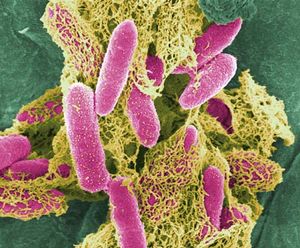IGEM:Caltech/2008/Project/Phage Pathogen Defense: Difference between revisions
From OpenWetWare
Jump to navigationJump to search
| (9 intermediate revisions by the same user not shown) | |||
| Line 12: | Line 12: | ||
==General Idea== | ==General Idea== | ||
[[Image:PathogenicEcoli.jpg|thumb|left|Pathogenic E. coli.]] | [[Image:PathogenicEcoli.jpg|thumb|left|Pathogenic E. coli.]] | ||
There are <math>10^14</math> bacterial cells that naturally reside in the human gut, an order of magnitude greater than all the cells in the body. Humans enjoy a mutualistic relationship with intestinal microbiota, wherein the microorganisms perform a host of useful functions, such as processing unused energy substrates, training the immune system, and inhibiting growth of harmful bacterial species [1]. | |||
However, not all bacteria populations within the human intestine are benign. There are many pathogenic bacteria which cause a wide variety of diseases when present in the human gut. As one example, cholera is one of the most widespread and damaging of such infectious microorganisms, with the World Health Organization reporting 132,000 cases in 2006 [2]. But cholera is just one of many examples. In the United States alone, there were more than 325,000 hospitalizations from food-borne illnesses in the year of 2006 [3] | |||
There are many medical treatments for food-borne illnesses, the most commonly prescribed being antibiotics. Unfortunately, antibiotics are indiscriminant and lead to rapid depletion of benign bacterial populations within the intestine. Due to this fact, dietary supplements have been popularized which aim to introduce beneficial bacteria back into the gut after antibiotic treatment; these substances have been termed ‘probiotics’. Natural probiotics have two main advantages: they provide useful functions for the host and they competitively inhibit growth of pathogenic bacteria. | |||
Natural probiotics do not convey any more advantages than bacteria in a healthy human intestine. Modern synthetic biology techniques should allow us to create an engineered probiotic that goes beyond the limitations of natural probiotics. The viability of such engineered probiotics within humans has already been established [4]. There are many ways for the engineered probiotic to combat pathogens in the large intestine; however, the method of using bacteriophages for pathogen defense was chosen. Bacteriophages present a novel and effective agent for eliminating pathogenic bacteria. Two important factors contribute to a bacteriophage’s effectiveness: bacteriophages are highly infectious and thus highly efficient at destroying targeted populations, and bacteriophages are specific to their hosts. The latter factor is readily illustrated by the coliphage λ, which possesses a mode of infection dependent on an E. coli specific surface protein, lamB[5]. Benign, non-E. coli intestinal bacteria lack this surface receptor and therefore are immune to destruction. | |||
The engineered probiotic acts as a delivery vehicle for phage into the large intestine. There are four important design goals for such as system.: (1) the system releases phage into the large intestine, (2) the production of phage is regulated with a high dynamic range between a distinct on and off state, (3) the system can target a wide range of pathogenic bacteria, and (4) the system integrates well within the existing iGEM probiotic. | |||
==Part I: Lambda Phage== | ==Part I: Lambda Phage== | ||
| Line 24: | Line 30: | ||
[[Image:SystemDesign 1.jpg |frame|center|50px|Design for the lamB+tetA constructs used for lambda infection and tetracycline counterselection.]] | [[Image:SystemDesign 1.jpg |frame|center|50px|Design for the lamB+tetA constructs used for lambda infection and tetracycline counterselection.]] | ||
The second plasmid which must be designed controls the induction of the lysogens to release phage into the environment. Control of this aspect of the system is vital for integration with the overall iGEM project. In general, λ lysogens stay in lysogeny until some trigger, usually cellular stress. However, we want to be able to induce the lysogens into the lytic cycle, this is done through the over expression of the E. Coli gene rscA, which has been shown to bring lysogens into the lytic phase. Currently, the rscA gene has been placed behind the luxR repressor/activator. This repressor prevents expression of rscA until activation via acyl-homo-serine lactone (AHL). However, within the final project, rscA will most likely be placed in the control of Allen's random differentiation generator. Furthermore, the final system will be similar in nature to Doug's, with a inverter after the activation of rscA, this is shown below. | |||
[[Image:SystemDesign 2.jpg |frame|center|50px|Design for the control system for control of lambda phage lysogenic/lytic life cycles.]] | |||
===Current Work=== | |||
Will be updating when it is not 6 am. | |||
===Constructs=== | |||
Same as above | |||
==Pard II: B. Subtilis Lysogens== | ==Pard II: B. Subtilis Lysogens== | ||
===Basic Idea=== | |||
[[Image:Phasmid Construction.jpg|thumb|left|Phasmid Assembly]] | |||
We wish to create a phasmid, basically the lysogen genome with an E. Coli plasmid origin of replication, using B. Subtilis lysogens. This allows the phage genome to pass on as a plasmid within our engineered E. Coli, but when the plasmid is conjugated to B. Subtilis, the virus is induced and destroys the pathogens. Phasmid construction will an E Coli origin of replication with a Subtilis specific promoter in front of RecA or another inducer. | |||
===Current Progress=== | |||
Three different bacteriophage lysogens and three wildtype strains of B. Subtilis has been ordered from the Bacillus Stock Center. However, efforts to induce the bacteriophage from the lysogens with UV exposure has proved to be futile thus far, however, this was possibly due to a contamination of the lysogen stocks. The strains have been reordered and B. Subtilis lysogen induction with UV occurring soon, most likely the week of 8/4. | Three different bacteriophage lysogens and three wildtype strains of B. Subtilis has been ordered from the Bacillus Stock Center. However, efforts to induce the bacteriophage from the lysogens with UV exposure has proved to be futile thus far, however, this was possibly due to a contamination of the lysogen stocks. The strains have been reordered and B. Subtilis lysogen induction with UV occurring soon, most likely the week of 8/4. | ||




